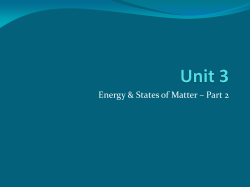
Exam Review Page 5 - PlantLectures.com
Chemistry Semester 2 Exam Review Last Name_________________________ Per___ Unit 13: Thermochemistry& Reaction Rates Essential questions: What are some types of renewable and nonrenewable energy resources? What is energy and how is it measured? What is the difference between temperature and heat energy? What is an endothermic process and what is the sign for ΔH for the process? What is an exothermic process and what is the sign for ΔH for the process? What is the SI unit for energy? How are system, surroundings, and universe defined in thermochemistry? How is the Law of Conservation of Energy applied using calorimetry? What is specific heat capacity? Why does it take more heat to change the temperature of water compared to metals? What factors impact the rate of a chemical reaction, and how is the rate changed for each factor? How are endothermic and exothermic reactions represented in an energy diagram? What is a catalyst? How does a catalyst work? What is a reversible reaction? What do molecular clocks have to do with reaction rates? Key vocabulary: thermochemistry heat exothermic Collision Theory absolute zero specific heat renewable energy Reaction Rate source calorie calorimeter Concentration nonrenewable energy joule surroundings Surface Area source energy system Catalyst chemical potential law of conservation of universe Molecular Clocks energy energy endothermic Practice: 40. What is the derived unit for specific heat? ___________ 41. Select the word in the parenthesis that makes the statement true: An object with a higher specific heat requires (more / less) heat to raise its temperature. 42. How many kJ are equal to 500.0 calories? 43. What is the SI unit for energy/heat? __________ 44. Select the word in the parenthesis that makes the statement true: An (endothermic/exothermic) reaction releases heat so the container would feel (warm/cold) while an (endothermic/exothermic) reaction absorbs heat from the surroundings so the container would feel (warm/cold). 45. Select all the phrases in the parenthesis that make the statement true: The flat lines on a heating curve represent (a temperature change/ a constant temperature/ a change of state). 46. Select all the phrases in the parenthesis that make the statement true: The sloped lines on a heating curve represent (a temperature change/ a constant temperature/ a change of state). 47. Select all the phrases in the parenthesis that make the statement true: It takes longer for substances to (melt / boil) because the heat of vaporization is (higher / lower) than the heat fusion. 48. When a hot object is put in cooler water, what will happen to the temperature of the object? ____________ To the temperature of the water?_____________ 49. Convert 25oC to Kelvin. _________ Convert 25K to oC. __________ 9 Chemistry Semester 2 Exam Review Last Name_________________________ Per___ 50. Why are there no negative temperatures in the Kelvin system? ________________________________________________________________ 51. Which statement describes characteristics of an endothermic reaction? (check one) ____The sign of H is positive, and the products have less potential energy than the reactants. ____The sign of H is positive, and the products have more potential energy than the reactants. ____The sign of H is negative, and the products have less potential energy than the reactants. ____The sign of H is negative, and the products have more potential energy than the reactants. 52. Select all the phrases in the parenthesis that make the statement true: The average kinetic energy of a substance’s molecules (increases / decreases) as it cools from 273K to 263K. 53. Select all the phrases in the parenthesis that make the statement true: Solid X is placed in contact with solid Y. Heat will flow spontaneously from X to Y when (X is 20°C and Y is 20°C/ X is 10°C and Y is 5°C/ X is -25°C and Y is -10°C/ X is 25°C and Y is 30°C). 54. What is the total number of joules of heat energy absorbed by 15 grams of water when it is heated from 30.0°C to 40.0°C?The specific heat of water is 4.184 J/g°C. 55. The heat of fusion of water is 6.01 kilojoules per mole. What is the total number of kilojoules of heat that must be absorbed by a 15.0 gram sample to change the compound from a solid to a liquid at 0°C? 56. Salt A and salt B were dissolved separately in 100 mL beakers of water. The water temperatures were measured and recorded as shown in the table below: Salt A: Salt B: initial water temp. 25.1°C 25.1°C final water temp. 30.2°C 20.0°C Select all the phrases in the parenthesis that make the statement true: The dissolving of (only salt A was endothermic/ only salt B was exothermic/ both salt A and salt B were endothermic/ salt A was exothermic and the dissolving of salt B was endothermic). 57. How does each factor affect the rate of a chemical reaction? Factors that affect reaction rate: The rate of the reaction…. (Circle your choice) Concentration of the reactants increases Concentration of the reactants decreases Temperature increases Temperature decreases An inhibitor is added A catalyst is added The pressure of a reactant gas is increased The pressure of a reactant gas is decreased Increases Increases Increases Increases Increases Increases Increases Increases Decreases Decreases Decreases Decreases Decreases Decreases Decreases Decreases 58. Draw and label the following reaction diagrams. Be sure to label the activation energy (∆Ea) and the change in heat (∆H) on each diagram: Exothermic Exothermic with a Catalyst Endothermic 59. Fill in the missing terms: A _______________ speeds up a reaction by lowering the ________________ ______________ 10
© Copyright 2025









